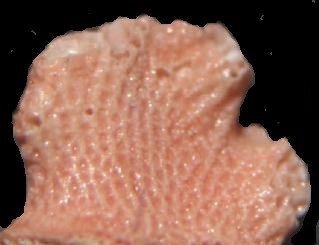
Mature Miniacina (Pallas 1766)
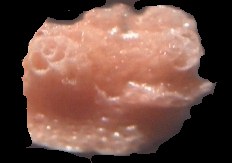
Test with multiple outgrowths
INTRODUCTION.
Anyone finding this protozoan for the first time might question its taxonomic place. At the first glance it might look somewhat like a small solitary coral. Only a thorough examination under the microscope will reveal that it clearly belongs to the Foraminifera.
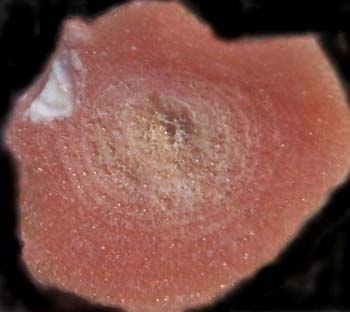
Under view of test
At sometime in the early 1920`s Edward Herron-Allen and Arthur Earland were chatting to a French diplomat called M. de Santa Maria in London. The subject of the conversation was mainly the bay at Ajaccio on the west coast of Corsica where the Frenchman was brought up. It is the same town where Napoleon was raised. He said that the sand on the north side of the bay was quite red in colour. The local people were of the opinion that this came from the erosion of the offshore islands of the Ils Sanguinaire which were dominated by rock of blood red granite. De Santa Maria however had examined the marine debris and was of the opinion that the colouration was entirely due to a small organism. Perceiving that the Englishmen had an interest and knowledge of these things, he invited them both to visit the Island. On their arrival, the English guests soon ascertained that the red sand was coloured by the empty tests of Polytrema miniaceum now called Miniacina miniacea. The concentration was something like 100 ml to a litre of sand.
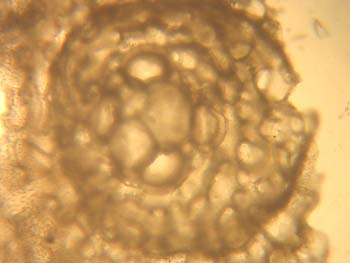
Section through the primary growth (raspberry stage);
surrounded by concentric growth.
MORPHOLOGY.
Most common Foraminifera develop from the zygote by a series of ever larger calcareous chambers in and around which, the protoplasmic soft parts are protected , grow and function. They may also develop by asexual budding. The different species form shell-like spirals of different shapes. Some become little larger than pinheads before they mature and die but some of our fossil ones at Selsey for example, reached the size of an old penny. In any event the flat or compound spiral is one of the characteristics of this order of animals.
At first Miniacina does not seem to show this trait. However if the base of the empty test is examined the primary spiral can usually be found. A light grinding will reveal the chambers. In Miniacina however, a raspberry like growth appears and then branching soon begins to occur and a series of concentric smaller cells create irregular protuberances. The living creatures may be found clinging to a wide variety of substrata. Most are reddish in colour but there is a greyish white form Miniacina alba (Carter1877). The Miniacina is found along the length of the Mediterranean Sea as well as some other seas where similar temperatures and conditions prevail.
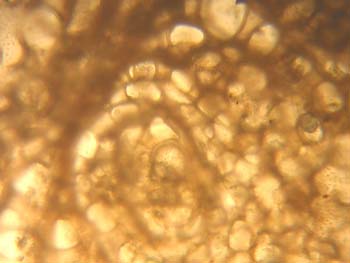
Section near the base
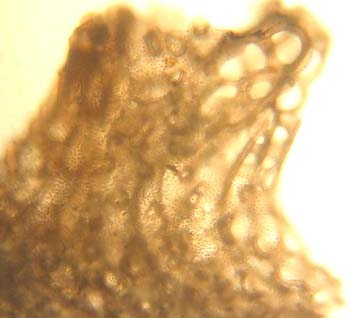
Vertical section of outgrowth
THE VISIT.
A few years ago I managed to visit the Island of Corsica. Travel was rather difficult on the island because of the mountainous terrain, but even in the splendid bays of the north west like L`Ile Russe, and at Calvi the same high proportion of Miniacina were to be seen gathering on the shoreline in the gentle waves.
THE PUBLICATION.
Herron-Allen and Earland were so delighted with their visit that they surveyed the whole of the bay and published a splendid little article in French called "Les Foraminiferes des Sables Rouges du Golfe d`Ajaccio" (ref. 1) in honour of their host M. de Santa Maria. There are some interesting diagrams of the significant stages of development of this organism, as well as drawings of the Foram.
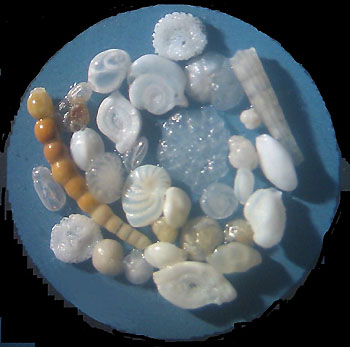
Other members of the Foraminifera from Corsica
REFERENCES.
1. Edward Herron-Allen and Arthur Earland. From "Bulletin de la Societe des Sciences Historique et Naturelles de la Corse". "Les Foraminiferes des Sables Rouges du Golfe d`Ajaccio" Published at Bastia 1922, pp109-149, Plates 1 and 2. Copies may be purchased from the British Museum of Natural History, South Kensington. London.
2. Darnton.B. "Balsam Post" Issue 52, ISSN 0961-043X, July 2001, P15-16. ("Balsam Post" is the quarterly magazine of the UK Postal Microscopical Society).
Also visit the author's home pages at www.darnton.freeserve.co.uk